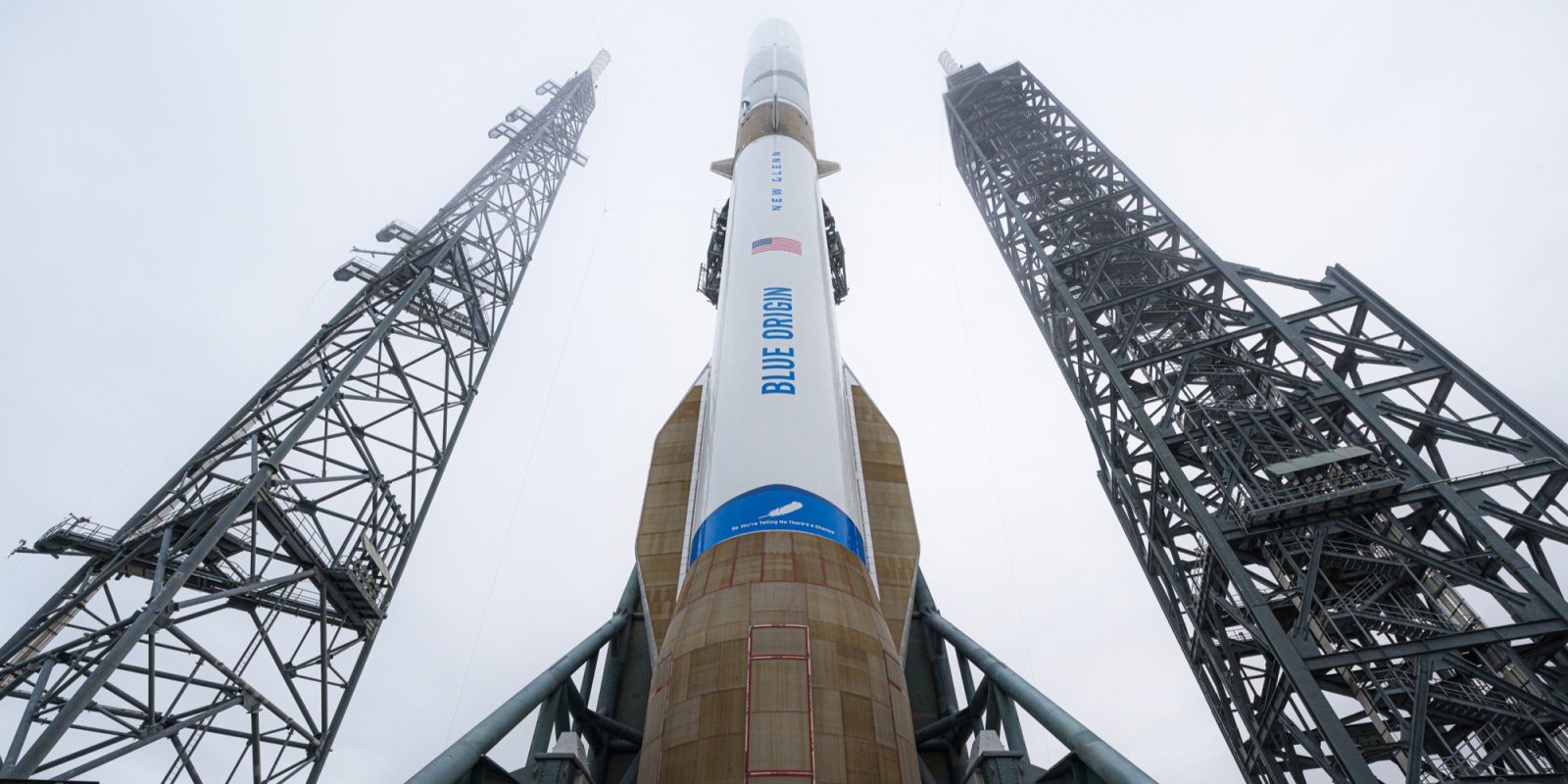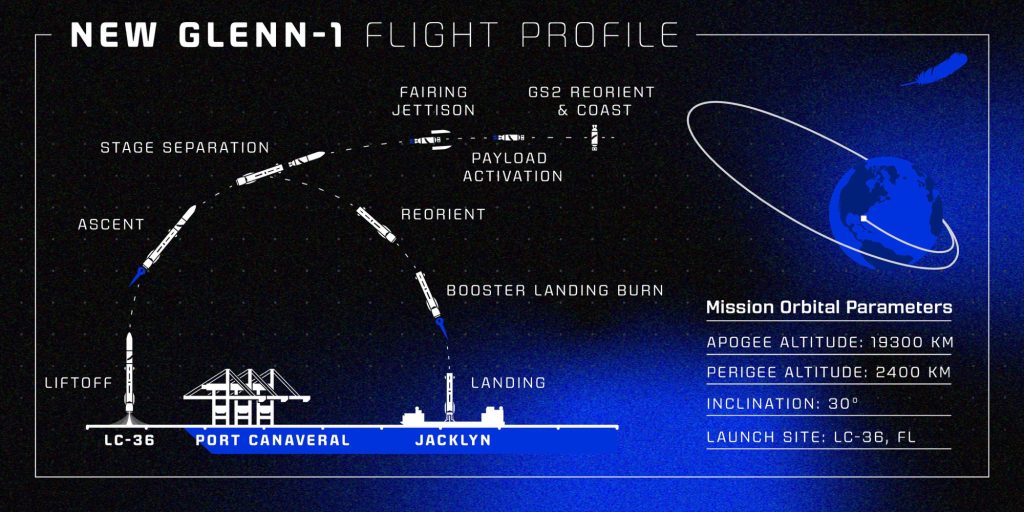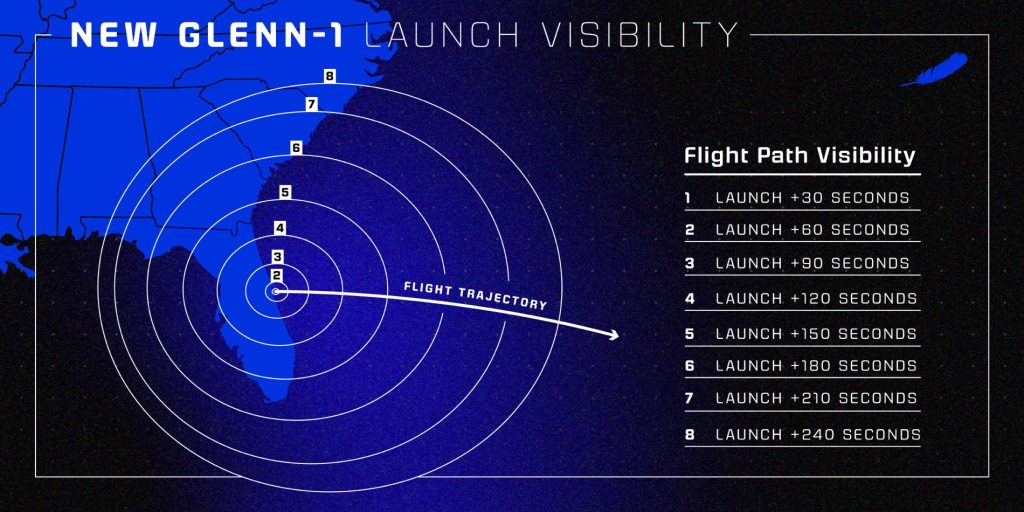
Later tonight, we’re expecting Blue Origin to launch its first New Glenn rocket, hopefully successfully. You might have a lot of questions as to what New Glenn is, why they’re launching this rocket, what it’s doing, and more. Here’s everything you need to know about New Glenn’s first launch.
Update: Blue Origin sends first New Glenn rocket into orbit
What is New Glenn
New Glenn is Blue Origin’s, an aerospace company founded by Amazon founder Jeff Bezos, orbital-class, heavy-lift rocket developed for commercial launch contracts. In the past, Blue Origin has only launched suborbital missions, going straight up for about a minute of zero-gravity; New Glenn will be the company’s move into commercial launch services.
The first stage, also known as GS-1, consists of seven BE-4 engines. Built in-house, the BE-4 is fueled by liquid oxygen and liquid methane. The total height of New Glenn is 94 meters or 322 feet, larger than SpaceX’s Falcon Heavy and the same height as NASA’s Space Launch System. The seven engines will produce an expected 3.85 million pounds of thrust to deliver the second stage into a suborbital trajectory but above Earth’s thick atmosphere.
New Glenn’s second stage, known as GS-2, consists of two BE-3U engines that are powered by liquid oxygen and liquid hydrogen. Compared to traditional rocket fuels like RP-1, which is a highly refined form of kerosene, hydrogen is much more efficient. This makes it a great fuel to use on a second stage while in space, where efficiency is everything.
The BE-3 is also the same engine used by New Shepard; the “U” at the end of the name indicates that changes were made for it to better operate in the vacuum of space.
On top of the second stage is the payload bay, which, during ascent, is encased in a 7-meter (23-foot) wide fairing. This sized payload fairing is the largest in the industry and will be able to support nearly any sized payload currently imaginable.
What is New Glenn-1 doing?
Blue Origin’s first orbital launch, called New Glenn-1, will be a pathfinder flight to gather flight data for Space Force certification. The flight will be the rocket’s first, so above all, the goal is to see how New Glenn performs in real-world conditions. Success will be gauged by how much they learn versus how far the rocket goes.
New Glenn will be carrying a pathfinder payload called Blue Ring. This payload won’t be deployed but is permanently attached to the second stage with the goal of testing its systems in space for the first time.
Blue Ring is an in-space platform being developed by Blue Origin to host payloads, serve as a rideshare kick stage, be a dedicated satellite bus for customers, and possibly be turned into the beating heart of a commercial space station.
New Glenn’s planned orbit will reach as high as 19,300 kilometers, which is just shy of 12,000 miles, and as low as 2,400 kilometers, about 1,500 miles. Blue Origin hasn’t stated how long the GS-2 stage will remain in orbit, but it is expected they will attempt to deorbit it as soon as the mission is completed so as not to leave any uncontrollable space junk in orbit.

Will I be able to see New Glenn launch?
If you live along the East Coast of the United States and are south of most of North Carolina, you should be able to see New Glenn lift off. Obviously, the closer you are to the launch pad, the brighter and more of the launch you will see.
Popular viewing locations along the Space Coast are Cocoa Beach and Jetty Park Pier. Parking will be limited, and it’s suggested you arrive early, as most first launch missions can gather large crowds. Given that this is also a fairly large rocket, that too will bring in larger crowds.
What you likely will not see is GS-1’s landing burn, as it should be just over the horizon. New Glenn also doesn’t perform a reentry burn like SpaceX does, so the booster will be nearly invisible to the naked eye after stage separation.

Is New Glenn reusable
Yes, New Glenn is partially reusable! Being only the second orbital rocket launched with reusability in mind from the start—the first was the Falcon 9, by the way—its booster is designed to propulsively land on a landing platform at sea.
New Glenn’s booster features several differences from SpaceX’s reusable boosters. First are two large strakes towards the aft of the rocket. These aren’t flaps like Starship as they can’t move, but they do add aerodynamic stability to the rocket. The strakes are also large enough to provide lift, although the booster’s body as a whole produces lift as well. This lift can be used to travel downrange towards the landing platform.
The booster also has four fins towards the top. These are what can actuate and provide attitude control during descent.
While the booster is powered by seven engines, not all of them will be used during the landing burn. Likely the booster will ignite three and finish with the center engine before, hopefully, landing on its platform.
Speaking of that platform, Jacklyn, Blue Origin’s sea-based landing platform seems to be the primary way New Glenn’s boosters will return home. Last week it was towed out to sea, roughly 700 km (435 miles). There, Blue Origin will attempt to do something not many in the industry expect to happen on the first try: landing the booster.
While SpaceX has made it look easy, it is still extremely difficult, and given the name of tonight’s mission, “So You’re Telling Me There’s A Chance,” Blue Origin might seem not too confident in it happening either. That doesn’t matter, however, as once again the main goal of New Glenn’s first launch is to gather flight data on the rocket. Landing, recovery, and reusability of New Glenn can come later.
Why does Blue Origin need New Glenn?
For the last few years, the only rocket Blue Origin has been launching is New Shepard, a space tourism-focused, suborbital rocket. While some research missions can be conducted with New Shepard, Blue Origin’s goal is to build large structures in space, and to do that, it needs a heavy-lift rocket.
New Glenn will also be used to launch its Blue Moon lunar lander for NASA and potentially other customers, can tap into the market of commercial launch contracts to diversify its revenue, and finally play a role in launching its Orbital Reef space station.
Without New Glenn, Blue Origin would be stuck launching with other providers, which could be costly for the company. Also, the market could use another cost-competitive heavy-lift launcher, so it just makes sense for Blue Origin to move into this sector.
What’s the importance of this mission?
Speaking of other launchers, the current market is being dominated by SpaceX and its Falcon 9 rocket. Soon, the company will bring Starship online and continue to dominate. The only other US heavy-lift launcher on the market is ULA’s Vulcan, which can compete only because it’s not SpaceX, and sometimes you just want diversification.
We mentioned earlier that this will be the first certification mission for the Space Force. The US government will be a big customer for New Glenn as it hopes to diversify who it launches its national security missions with. That goes for the commercial industry too. A monopoly, no matter how good at pricing, is never healthy for the market long term. Having options that are all well-priced is the best option for those looking for rides into space.
When might New Glenn fly again?
If all goes well, which is not ruled out but also not entirely expected, Blue Origin has four other New Glenn launches on its 2025 launch manifest. Two of those are pathfinder missions for its Blue Moon lander, another is for Amazon Kuiper satellite internet, and another is NASA’s ESCAPADE mission to Mars. This was originally scheduled to be New Glenn’s first mission but was delayed when NASA determined Blue Origin wouldn’t be ready by the end of 2024’s Mars transfer window.
No other date has yet been set for the next New Glenn launch, but the first of those two Blue Moon pathfinder missions is set for no earlier than March, and ESCAPADE is set for no earlier than the spring. Those two are likely the next missions to fly on New Glenn; however, dates for either will likely wait until after the outcome of Monday’s mission is known.
FTC: We use income earning auto affiliate links. More.




Comments